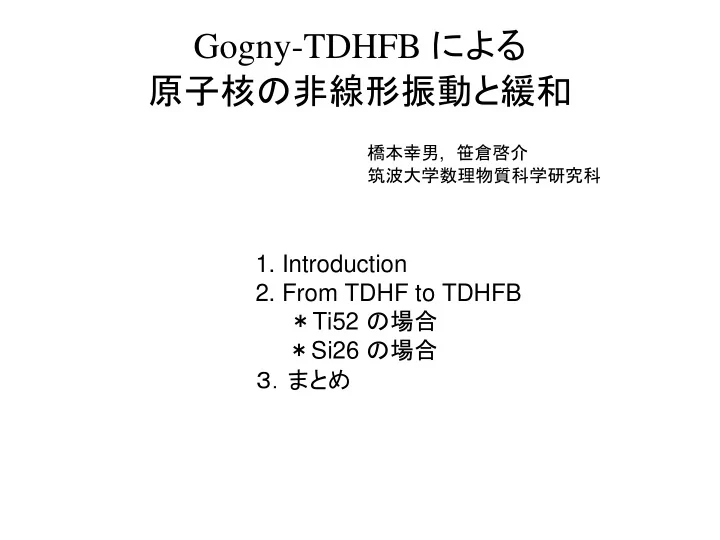

Gogny-TDHFB による 原子核の非線形振動と緩和 橋本幸男 , 笹倉啓介 筑波大学数理物質科学研究科 1. Introduction 2. From TDHF to TDHFB * Ti52 の場合 * Si26 の場合 3.まとめ
1 . Introduction 時間依存平均場理論 微小振幅 RPA, 規準振動 中間振幅( ? ) → 緩和、 … 大振幅 核反応、融合、分裂
エネルギーの移動 : 相対運動 内部の集団運動・核子の運動 one-body dissipation (2 body collision neglected) その微視的なメカニズムは ??? chaotic motion in TDHF (?)
BKN force TDHF three-level model
2. From TDHF to TDHFB ☆対相関の効果を時間依存平均場で見る ⇒ エネルギー移動の仕組みを理解する
see Ring & Schuck Equations of motion of matrices U & V
Gogny ‐ D1S Gauss part density depende part L ‐ S part Coulomb part is NOT included ・basis function:three-dimensional harmonic oscillator wave functions ・space: N n n n 5 shell x y z
初期条件 ・ Q 20 type impulse on ground state ( impulse type ) ・ CHFB 状態( constraint type ) initial U & V HFB ground state U, V : matrix representation of Q 0 multipole operator
Example-1: 20 O quadrupole oscillation (small amplitude)
Example-2. Spherical case: 26 Ne IV dipole response TDHFB (Nshll = 5) S. Peru, H. Goutte, J.F. Berger, Nucl. Phys. A788(2007), 44-49.
52 Ti の場合 ☆ 微小振幅・小励起エネルギー ⇒ 大振幅・大励起エネルギーへ
Total Energy Pairing E (p) Pairing E (n) Energy Energy [MeV] pairing energy Q 20 [fm 2 ] oblate prolate energy curve E vs <Q 20 > ( 52 Ti (Z = 22, N = 30))
Total Energy Pairing E (p) Pairing E (n) Energy [MeV] constraints impulse (4.32[MeV]) Q 20 [fm 2 ] … pairing in neutrons ( impulse 、 Q 20 = 140 , 230 〜 240 [fm 2 ] ) initial conditions = 150 〜 200 [fm 2 ]) … NO pairing in neutrons (Q 20
[fm 2 ] [fm 2 ] Q 20 Q 20 … no pairing in neutrons … pairing in neutrons = 85 [fm 2 ] = 0 [fm 2 ] oscillation around Q 20 oscillations around Q 20
・ two types of oscillations after relaxation process ・ effects of pairing correlations in oscillating motions put focus on the occupation probabilities of TDHFB orbitals
= 85 [fm 2 ] (constraint Q 20 = 170 [fm 2 ]) Case 1: oscillations around Q 20 time dependence of occupation probability(neutrons) [fm 2 ] Q 20 initial condition : Q 20 ・ no pairing in neutrons = 170 [fm 2 ] Ex = 2.56[MeV] no jump into ground state pocket ( Q20 = 0[fm^2]) E_pair(proton) = ‐ 3.55[MeV] E_pair(neutron) = 0 [MeV]
Case 2: oscillations around ground state ( Q20 = 0 [fm^2]) (impulse type) time dependence of occupation probability(neutrons) [fm 2 ] Q 20 impulse type ・ two main trajectories Ex = 4.32[MeV] ・ Q 20 oscillation seesaw in occupation probabilities E_pair(proton) = ‐ 4.79 [MeV] E_pair(neutron) = ‐ 2.75 [MeV]
= 140 [fm 2 ]) Case 3: jump into ground state pocket (constraint Q 20 time dependence of occupation probability(neutrons) Q 20 [fm 2 ] [fm 2 ] Q 20 initial condition : Q 20 = 140 [fm 2 ] ・ sudden change in occupation probability Ex = 1.37[MeV] Q20 oscillation jumps E_pair(proton) = ‐ 3.27 [MeV] ・ characteristic two orbitals E_pair(neutron) = ‐ 0.07 [MeV] ・ in phase with Q20 oscillation
variations of occupation probabilities of two main trajectories (constrait Q 20 = 140 [fm 2 ]) 拡大図 prolate oblate prolate side … green orbital main ( n x , n y , n z ) = ( 3, 0, 0 ) oblate phase … blue orbital main ( n x , n y , n z ) = ( 0, 3, 0 ) , ( 0, 0, 3 )
52 Ti (Z = 22, N = 30) ⼀粒⼦エネルギー ( 中性⼦ ) E F p 3/2 f 7/2 d 3/2 Energy [MeV] s 1/2 d 5/2 p 1/2 p 3/2 s 1/2 Q 20 [fm 2 ] oblate prolate change of occupation probability quadrupole oscillation
= 240 [fm 2 ]) Case 4: slow relaxation (constraint Q 20 準粒⼦軌道の占有率の時間変化(中性⼦) Q 20 [fm 2 ] initial condition : Q 20 = 240 [fm 2 ] slow relaxation Ex = 7.37[MeV] ・ occupation probabilities of many orbitals change E_pair(proton) = ‐ 4.79 [MeV] → two main orbitals becomes unclear E_pair(neutron) = ‐ 0.89 [MeV]
165 [fm 2 ]) Case 5: from oblate (initial Q 20 = ‐ 準粒⼦軌道の占有率の時間変化(中性⼦) initial condition : Q 20 = ‐ 165[fm 2 ] Ex = 4.25 [MeV] E_pair(proton) = ‐ 4.32 [MeV] E_pair(neutron) = ‐ 2.16 [MeV]
Time [fm] Energy [MeV] [fm 2 ] Q 20 Impulse type Initial Q20 = 140 Initial Q20 = 240 Initial Q20 = 200 Ex E= 4.32[MeV] Ex E= 1.37[MeV] Ex E= 7.37[MeV] Ex E=4.32 [MeV] Pairing E (p)= ‐ 4.79[MeV] Pairing E (p)= ‐ 3.27[MeV] Pairing E (p)= ‐ 4.79[MeV] Pairing E (p)= ‐ 4.19[MeV] Pairing E (n)= ‐ 2.75[MeV] Pairing E (n)= ‐ 0.07[MeV] Pairing E (n)= ‐ 0.89[MeV] Pairing E (n)=0 [MeV]
(MeV) Amplitudes of slow oscillations with excitation energy from 2.72 to 10.85 [MeV] grow very slowly.
Si26の場合 対エネルギー (MeV) Q20 vs 時間 Q20 (fm^2)
まとめ 微⼩振幅から振幅を増加させたときの核の振動運動と、 その時の対相関の働き → Gogny ⼒を⽤いた TDHFB 法により、 52 Ti などの四重極型振動運動 中性⼦の対相関の有無によって、 ⼆種類の振動モードが現れる 基底状態まわりの振動 ・四重極振動と、粒⼦が詰まる軌道の⼊れ替わりが対応 → 断熱的描像 ・中性⼦の対相関の効果によって、四重極振動の周期や、 基底状態まわりに乗り移るまでの時間が決まる
Recommend
More recommend